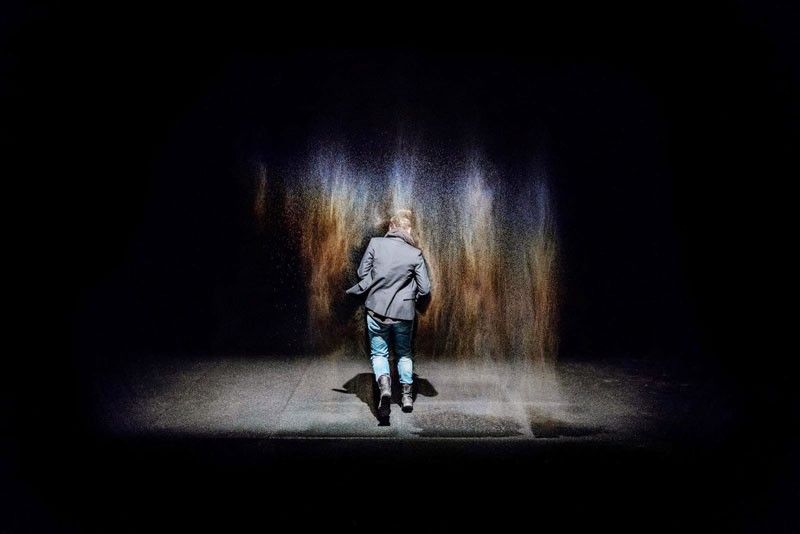Watermarks in a burn-out world

Olafur Eliasson. Tokyo, Japan.
Normally (not new-normally), that combination of words would have me scurrying to book plane tickets and Airbnb accommodations (courtesy of my girlfriend, who is the mind-hunter of not-so-expensive trips).
If this had happened in 2018 or 2019 B.C. (Before Coronavirus), we would have had our minds blown by the Danish-Icelandic artist’s exhibition at the Museum of Contemporary Art Tokyo (MOT), with cold Suntory beer, hot ramen and holy-grail hunting at Recofan and Disk Union on the side.
After all, Eliasson is the man responsible for weather projects, black horizons and green rivers (look ’em up).

But since we are right smack in the middle of Earth’s most challenging season so far (with the pandemic, bushfires, a volcanic eruption, earthquakes, the killing of George Floyd and the subsequent rallies and riots, the orange man in the bunker ready to unleash vicious dogs and ominous weapons… and with aliens probably warming up in the bullpen), we must content ourselves with experiencing art from afar — as we have done during long stretches of the lockdown, liquor ban and curfew (as if the virus only travels at night and spares the sober).
By the way, where the hell is that feng shui expert who declared that 2020 would be a lucky and prosperous year? Hmm… probably prosperously feasting on cans of sardines and packets of Lucky Me instant noodles just like the rest of us during those three infinite months. (And we are not yet in the clear, not by a long shot. This is not New Zealand, Taiwan or Vietnam; we are in the terrifying anti-terror capital of Asia.)
Art usually holds the light during the darkest of nights, provides us with moments of clarity. Thus, these words from Olafur Eliasson resonate with us, although on a different level: “I am holding a small power station in my hand with sunshine I brought from Berlin to Japan,” he declared in April last year. He was holding a “Little Sun” lamp — a solar-powered mobile light he created “to provide clean, affordable energy to those without access to electricity.”

On view at the MOT until Sept. 27 is Eliasson’s “Sometimes the river is the bridge,” which features a representative selection of the artist’s works that have never been exhibited in Japan. Consider it a “sampler” (not a greatest-hits collection), which features “early and recent installations that use natural materials; sculptures that reflect Eliasson’s long-held interest in light and geometry; photographic series; drawings and watercolors; and documentation of several of the artist’s interventions in public space.”
Here are some of the highlights:
“Beauty” is an early installation that makes use of a spotlight shining obliquely through a curtain of mist. And, since the interplay of water and light changes in response to the viewer’s positions within the room, a viewer cannot step into the same river twice, so to speak.
“Sunlight Graffiti” invites visitors to create drawings using light from the artist’s solar-powered lamps. This reminds us of Picasso’s light drawings for Life magazine in 1949.

A shallow pool and a small vibrating motor — Olafur makes use of them to create infinitely changing “drawings” borne out of the dynamic interplay of water, movement and light in the “Sometimes the river is the bridge” installation. According to the artist, “(This) is about a fundamental shift in perspective that allows us to see that which is not obvious, the invisible.” This piece encourages us to project our own visions on the black walls.
In the aforementioned installation, I am not quite sure whether this experience can be gleaned online via a desktop or a smartphone in a living room in a house in a city situated in a country under a black cloud of death knells, ballooning debts, and disappearing freedom (let’s just get those thoughts in before the purge, the witch hunts and the Minority Report-style arrests begin). In the new abnormal, how we ingest and digest art has been altered and is constantly being refined and redefined.
But art as seen from the insanity of our sofas — from the likes of Banksy to Richard Tuttle to our very own Filipino Social Realists — does what art is supposed to do. It livens up our empty rooms, gives us a sliver of hope and the urge to overcome — and to not let those bastards grind you down.
Sometimes the river is the bridge, muses Olafur Eliasson. But, to paraphrase Steven Tyler, sometimes the light at the end of the tunnel may be us.

* * *
For an abbreviated tour of Olafur Eliasson’s exhibition, visit www.youtube.com/watch?v=VErQ0j76QpU&feature=youtu.be. Photos are courtesy of the Museum of Contemporary Art Tokyo (https://www.mot-art-museum.jp) and https://olafureliasson.net.



















